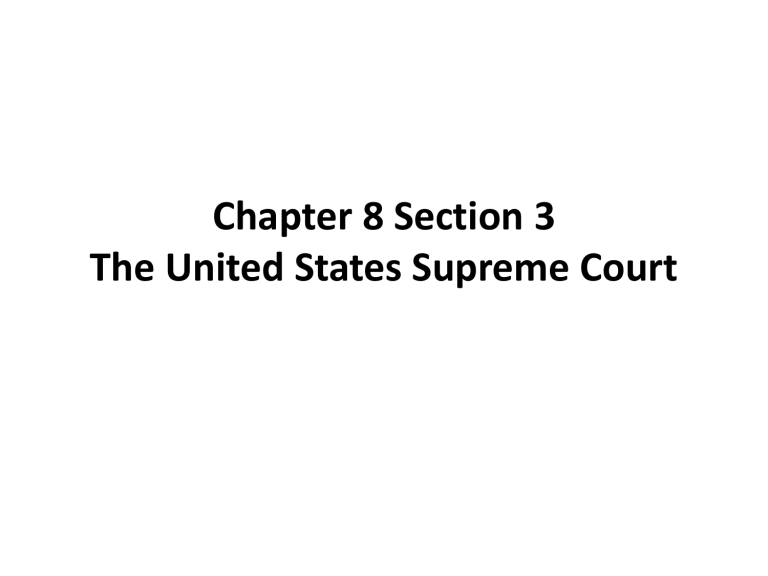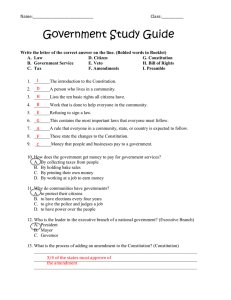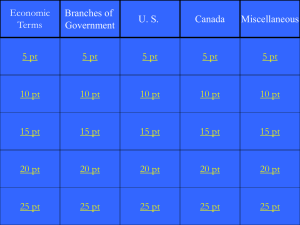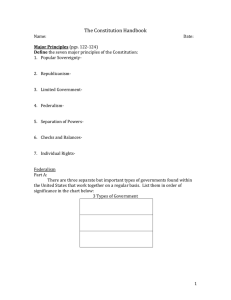Chapter 8 Section 3 The United States Supreme Court

Chapter 8 Section 3
The United States Supreme Court
• I. The Supreme Court Justices
• A. The main job of the nation’s top court is to decide whether laws are allowable under the
Constitution.
• B. The Supreme Court has original jurisdiction only in cases involving foreign diplomats or a state. All other cases come to the Court on appeal.
• C. The Court chooses the cases it hears. In cases the Court refuses to hear, the decision of the lower court stands. The
Court has final authority on cases involving the
Constitution, acts of Congress, and treaties.
• D. Eight associate justices and one chief justice make up the Supreme Court. After deciding a case, the justices issue a written explanation, called the Court’s opinion.
• E. The president appoints Supreme Court Justices, with
Senate approval. The president’s decision may be influenced by the Justice Department, American Bar
Association, interest groups, and other Supreme Court justices.
• F. Supreme Court justices are always lawyers.
A successful law career, political support, and agreement with the president’s ideas are factors in whom gets appointed.
• II. Powers of the Court
• A. The legislative and executive branches must follow
Supreme Court rulings. Because the Court is removed from politics and the influence of special-interest groups, the parties involved in a case are likely to get a fair hearing.
• B. The Court’s main job is to decide whether laws and government actions are constitutional, or allowed by the Constitution. It does this through judicial review – the power to say whether any law or government action goes against the Constitution.
• C. The Constitution does not give the Supreme
Court the power of judicial review. The court claimed the power when it decided the case
Marbury v. Madison .
• D. As President John Adams was leaving office, he signed an order making William Marbury a justice of the peace. The incoming president,
Thomas Jefferson, refused to carry out the order.
Marbury took his case to the Supreme Court.
• E. In the Court’s opinion, Chief Justice John
Marshall set forth three principles of judicial review: (1) The Constitution is the supreme law of the land. (2) If a law conflicts with the
Constitution, the Constitution rules. (3) The judicial branch has a duty to uphold the
Constitution. Thus, it must be able to determine when a law conflicts with the
Constitution and nullify that law.
• F. The power of judicial review serves as a check on the actions of the executive and legislative branches.
• G. Congress writes laws in general language.
Through its rulings, the Supreme Court interprets the meaning for laws, helping the police and other courts apply them.
• Discussion Question:
• Why is the power of judicial review an important part of the system of checks and balances?
• By declaring acts of Congress or executive orders unconstitutional, the Supreme Court can check the actions of the legislative and executive branches of government to keep them from straying too far from the
Constitution when they make and carry out laws.
• III. Limits on the Courts’ Power
• A. The Court depends on the executive branch and state and local officials to enforce its decisions. Usually they do.
• B. Congress can get around a Court ruling by passing a new law, changing a law ruled unconstitutional, or amending the Constitution.
• C. The president’s power to appoint justices and
Congress’s power to approve appointments and to impeach and remove justices serve to check the power of the Court.
• D. The Court cannot decide that a law is unconstitutional unless the law has been challenged in a lower court and the case comes to it on appeal. The Court accepts only cases that involve a federal question. It usually stays out of political questions.






